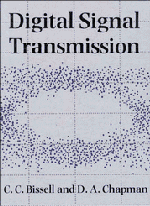Book contents
- Frontmatter
- Contents
- Preface
- 1 Introduction
- PART 1 MODELS
- 2 Signals and systems
- 3 Random signals and noise
- PART 2 PROCESSES
- PART 3 DIGITAL TRANSMISSION OVER THE PUBLIC SWITCHED TELEPHONE NETWORK
- Appendix A Fourier series and transforms
- Appendix B Convolution
- Appendix C Modelling applications of spreadsheets
- Answers to numerical exercises
- References
- Index
3 - Random signals and noise
from PART 1 - MODELS
Published online by Cambridge University Press: 05 June 2012
- Frontmatter
- Contents
- Preface
- 1 Introduction
- PART 1 MODELS
- 2 Signals and systems
- 3 Random signals and noise
- PART 2 PROCESSES
- PART 3 DIGITAL TRANSMISSION OVER THE PUBLIC SWITCHED TELEPHONE NETWORK
- Appendix A Fourier series and transforms
- Appendix B Convolution
- Appendix C Modelling applications of spreadsheets
- Answers to numerical exercises
- References
- Index
Summary
Introduction
The signal models introduced so far (periodic signals and isolated pulses) are all deterministic – that is, their behaviour at any instant in time is completely specified in advance. Clearly, though, the signals encountered in telecommunications systems do not often behave like this. The precise sequence of digital symbols transmitted as a message is not known in advance – otherwise there would be no point in transmitting it! And as far as noise is concerned, although the range of voltages to be expected might be known, there is no way of predicting the precise noise level at any particular instant in time. Many waveforms in telecommunications therefore need to be treated as random variables, and modelled using statistical tools. This chapter introduces such tools.
Statistical averages (means)
In Chapter 2 the mean value of a periodic signal was identified with its zero-frequency or d.c. component. A similar idea applies to a random waveform. If the random signal is lowpass filtered so as to remove almost all the time-varying components, as illustrated in Fig. 3.1, then the result is a waveform which wanders only slightly from its mean value or d.c. level. The mean value of a random waveform is therefore equal to its d.c. or zero-frequency component.
A mathematical expression for the mean value follows immediately. Fig. 3.2 is an enlarged version of the input to the filter in Fig. 3.1.
- Type
- Chapter
- Information
- Digital Signal Transmission , pp. 62 - 94Publisher: Cambridge University PressPrint publication year: 1992
- 1
- Cited by



